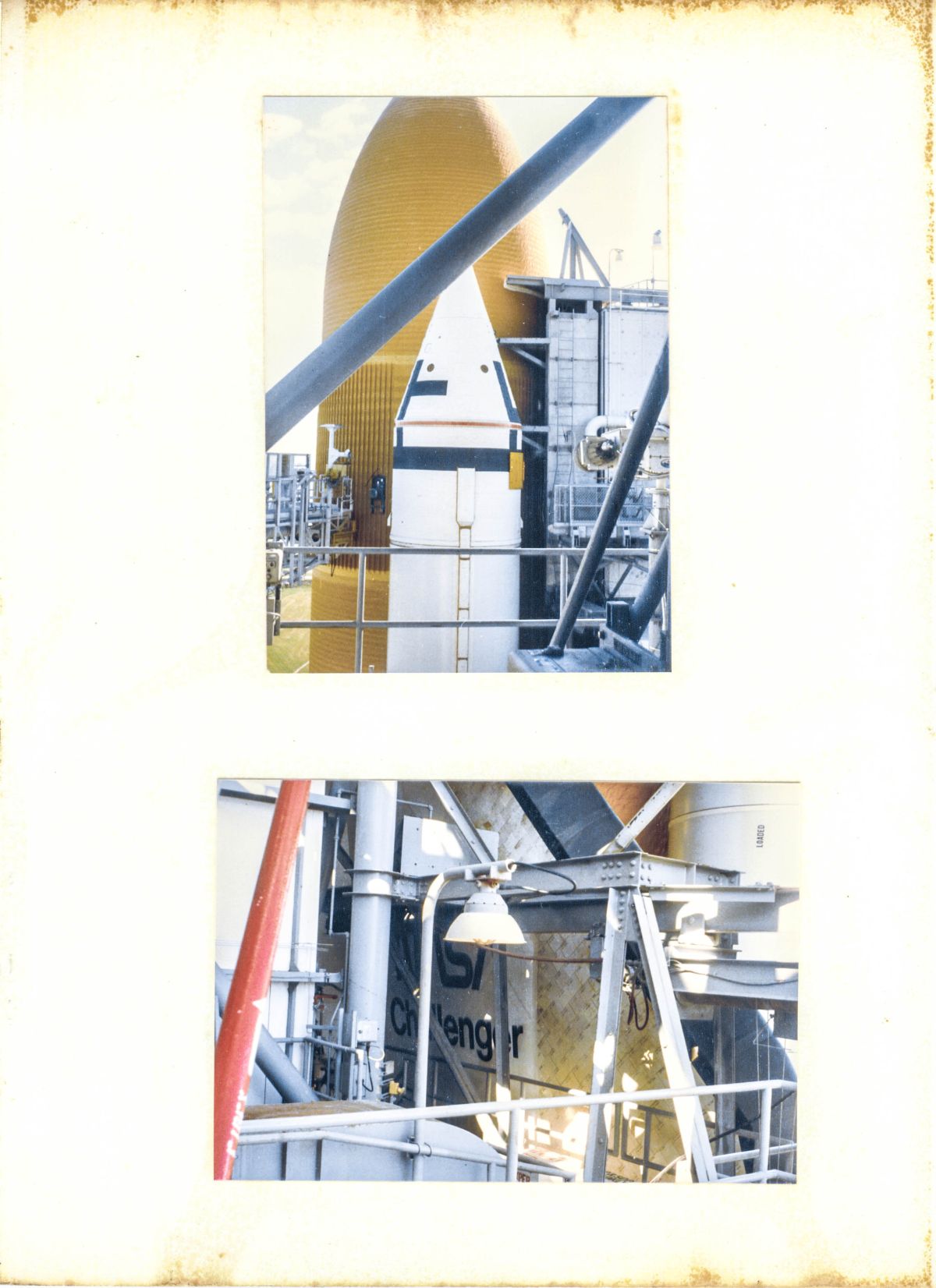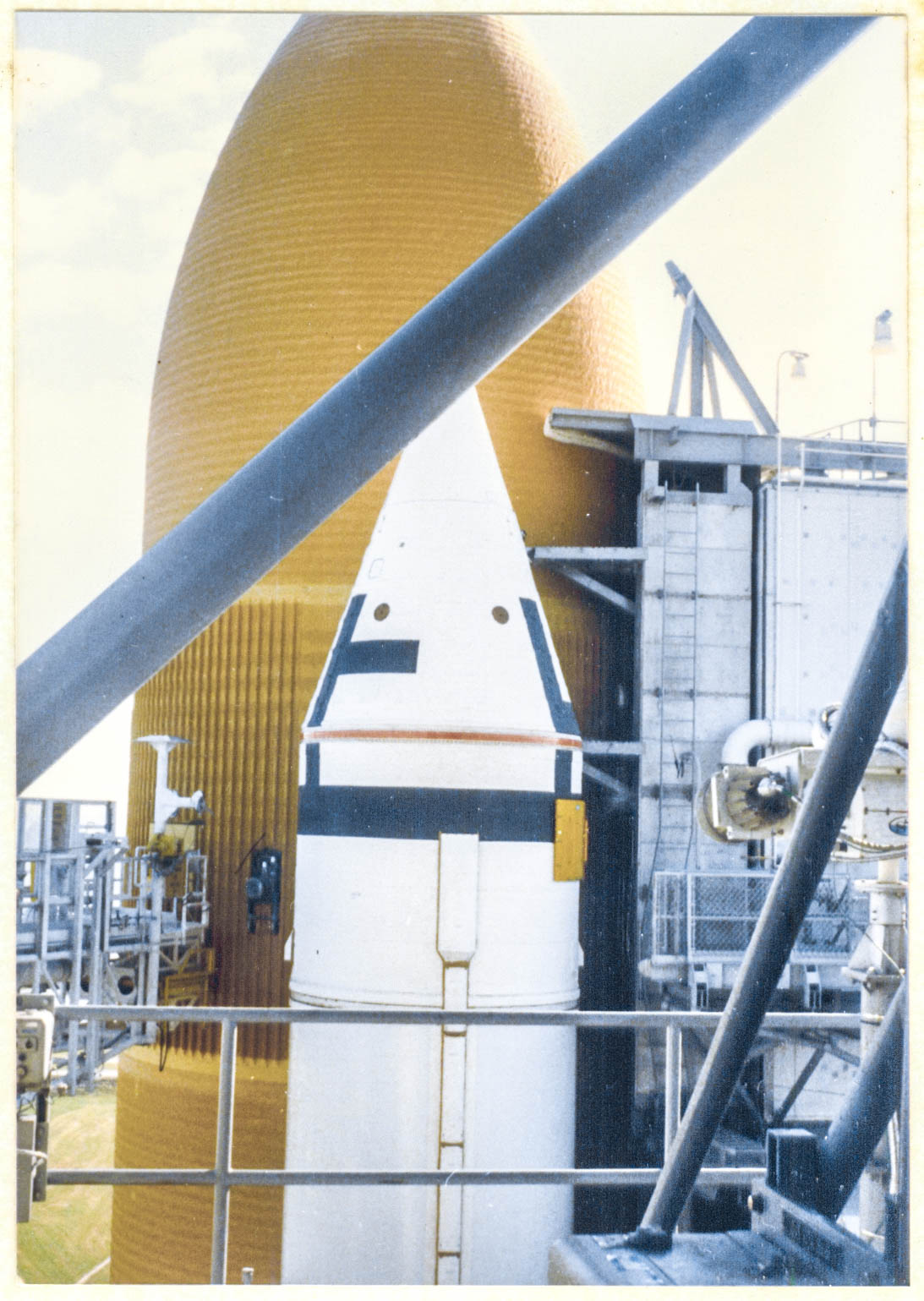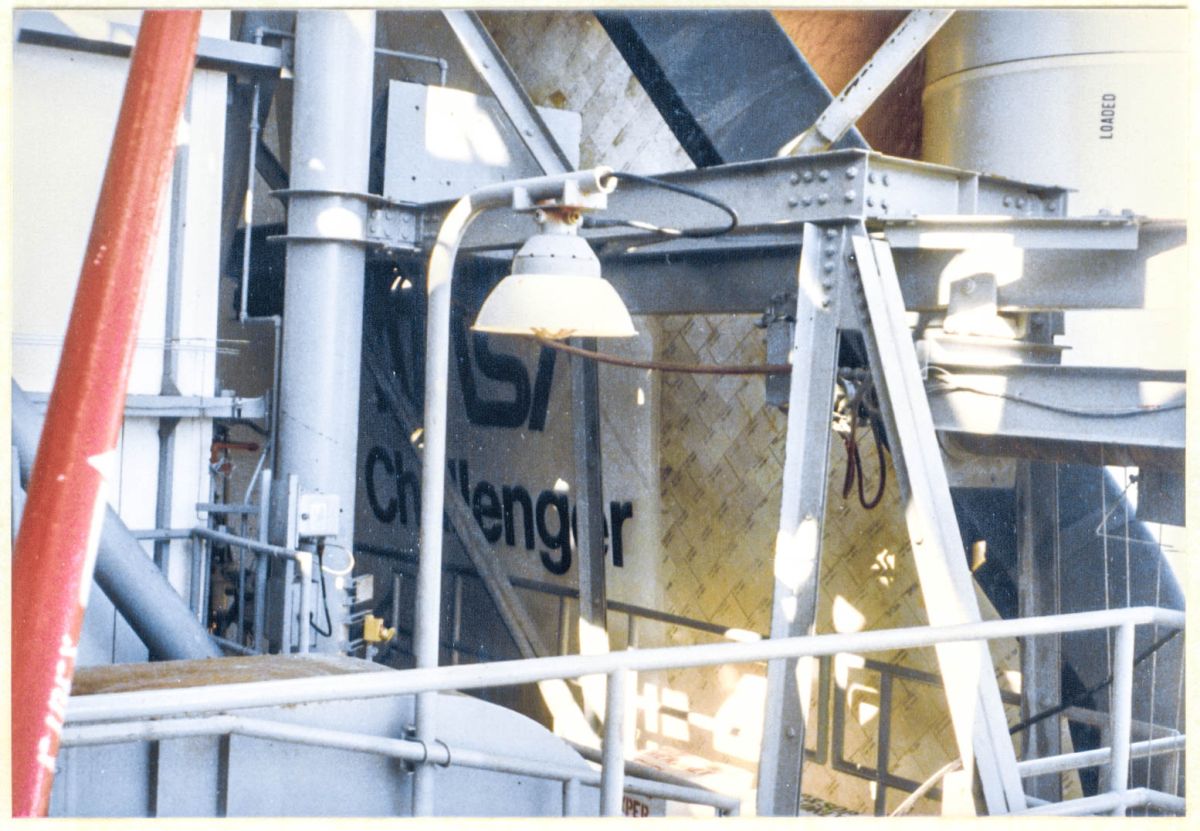Space Shuttle Launch Complex 39-B Construction Photos
Page 26
Challenger on B Pad - Page 2
(Original Scan)
The top photograph is taken from the FSS, showing the top of the left SRB with the External Tank behind it.
Bottom photograph is from the RSS, in the area of the accessway to what was called the PBK & Contingency Platforms, if fallible memory serves me well, showing the top of the right wing.
Additional commentary below the image.

Top:
(Full-size)

Looking across from the FSS directly east, in the direction of the Atlantic Ocean, at the top of the left SRB with the ET behind it, from the elevation of the top of the IAA. The RSS has been rotated around through its full arc of 120 degrees, to bring it into the mate position with the orbiter which is on the pad.
From this perspective, several things are worth noting.
Going out of the right side of the frame, all along the middle, is the RCS Room, our view of which is blocked in part by an OTV camera sitting on top of its support pedestal with floodlights attached to its sides, much closer to where I took this picture from, in the foreground, which itself is partially blocked by a couple of gray pipes or conduits running at a diagonal, which are even closer. Blocked from view, inside of the RCS Room, is Challenger's nose, which includes the Forward Reaction Control System, which is the orbiter's forward set of thrusters that are used to reorient it in space, where there's nothing to push against if you'd like to move something around, so you have to use small rockets to do everything. The RCS Room is there to provide access to that set of RCS thrusters for servicing. Those thrusters have a special type of rocket fuel, which is extraordinarily toxic and corrosive, and is just generally all-around psychotically nasty and life-threatening stuff.
In addition to providing access to the front end of the orbiter in its interior areas, the RCS Room also provided just a bit of, in one very small area, access to the External Tank. I have already mentioned access to the ET when the bird was on the pad, and I will revisit other aspects of that subject again, later, but for now we're just going to stick to the RCS Room itself, ok?
There was a stair that took you to the back side of the roof of the RCS Room, and the front side of the roof, the side of the roof that faces the ET when the RSS is in its mated position, provides access to an overhang with a curved leading edge that exactly matches the curve on the ET. That overhang was up above the main elevation of the roof itself, coming up like a shelf at maybe around waist level if you had walked over to the very front edge of the roof, right there in the center, and the foam insulation on the tank would be right there, at an easy arm's reach, from where you were standing, kind of leaning up against where that overhang connected to the RCS Room roof itself.
You could also get up on top of that overhang, to either side, to get direct access to the foam insulation on the tank, where the receding curve of the tank placed it much farther away than arm's reach from the leading edge of the RCS Room roof, but you really wouldn't want to be doing that, because there were no handrails anywhere to keep you from going over the side, and it also got kind of skinny and unpleasantly narrow for placing your feet, way out there on the tips of things, on either side, and you could never ever so much as brush against the foam insulation covering the ET to maintain your balance or otherwise steady yourself or prevent yourself from falling nearly two-hundred feet to your death.
Although they never said it out loud, and it was certainly not anything you could find even obliquely mentioned in official policies, I'm pretty sure that NASA would vastly prefer you dead over their having to go through whatever they might have to go through, following the sort of incident in which someone might have had to forcefully claw their fingers into that soft yielding foam insulation which covered the tank, in an effort to save their own very unworthy life.
This unpleasantly skinny area is plainly visible in the image above, in the area between the main body of the RCS Room and the very top of the left SRB. And you can also plainly see the inflatable seal that ran along the curve of this area, kind of draped down, almost like a nice soft quilt, (be sure to zoom right on in to see this properly) or maybe a down comforter, right there at the very edge of things, right up against the tank.
This whole thing, this whole big platform that sat at waist level, just above the main level of the RCS Room roof, and protruded out forward of the main envelope of the RCS Room towards the External Tank, was never intended to be there in the first place, and wound up getting designed and constructed as part of the larger change-order lunacy that begat the whole series of guide columns nightmares. Look close at the roof line of the RCS Room, farther back, away from the tank, and you can not only see that it's definitely at a lower elevation than the curved platform that sticks out in front and above it, but that the forward edge of the RCS Room actually stops a fair bit back, away from the tank.
Running horizontally just above the top of the roof, there's a pretty hefty steel beam that goes out toward the tank, but not quite as far out as the curved tips of the platform we've been talking about.
That beam extends well beyond the forward edge of the RCS Room, and has nothing to do with the RCS Room itself, and instead is there to support the top section of the goddamned guide columns, which is the stuff that looks like it's the forward side of the RCS Room, but it's not. Zoom in. Look close. See that ladder there? Yeah, that one. The one that's on that set of panels that are closest to the tank, which extend in this image, out pretty close toward the SRB.
And while you're at it, get a load of what that fucking ladder does just before it gets to the level of the handrail on the left SRB Access Platform that has the chain-link fencing draped on it. Immediately left and below the left floodlight on the OTV Camera I mentioned back there. Yeah. Check that shit out. How'd you like to be the guy who had to go out on that goddamned ladder and do whatever the hell it was that they needed done out there? NASA is insanely safety-conscious, but at one and the same time, they're also just insanely insane, too. Engineers. God, don't get me started on engineers, please.
Anyway, back to the stuff the ladder is on top of. That stuff is the ET Access Platforms Guide Column System. Or at least the very top part of it, over on the left side of the tank. There's more of it, and lot's more of it, going farther down, and still more yet, over on the other side of the tank, also extending for quite the vertical distance.
And of course, since the original modification itself got modified, when we originally built the goddamned things, that paneling you can see there, the panels with the ladder running up them almost to the big support beam that's holding the whole schmutz up; none of that paneling was there. It was all just an open latticework. Open steel framing with nothing on top of it to cover it up like it is in this picture.
And there, peeking out toward the SRB, below the platform that's just above the roof of the RCS Room, sticking out to the left away from the paneling that the ladder is more or less flush up against, can be seen the tips of the support framing of the far outer edges of both the upper and the lower left-side ET Access Platforms, which of course were mobile, and rode up and down upon, and were kept right where they belonged (in theory at least) by, the guide columns themselves. You're seeing them here in their uppermost, stowed, position on the guide columns.
The rest of these seemingly innocuous and uninteresting little platforms is hidden from view behind the paneling.
These platforms provide uninterrupted physical access to the External Tank, along the entire vertical run of that tank, in the narrow space between the belly of the orbiter and the tank itself. These platforms are split right in the middle, at their narrowest point, and each half (which constitutes a complete independent and distinct platform on the left and right side) is hinged farther back toward the wider end of things, creating a skinny little flip-up panel that can be lifted up out of the way which permits them to travel up and down above and below the areas where the support struts connect the tank to the orbiter.
And these are the platforms that almost killed one of our ironworkers. The upper one, actually. On this side. The left side. And when the upper one fell, it fell until it hit the lower one. And since the lower one was pinned in place, that's as far as things went, and our ironworker suffered a leg-breaking jolt when the platform he was falling with collided with the platform beneath it that was pinned in place, but the jolt was insufficient to send him over the side.
So that's kind of nice, I guess.
In a very left-handed manner of speaking, anyway.
And as I've mentioned before, I was not out on the tower that day, and for that reason I do not know exactly what our ironworker was using the platform to get access to, nor exactly where, vertically, the platform was when it let go, nor where, vertically, the platform that was pinned in place beneath it was, when it stopped him from falling any further.
And elsewhere in this image, moving on to another subject altogether, over on the left side of things, you can see where the Intertank Access Arm provides access to the ET for the installation and servicing of the elephant's trunk, which is neither connected nor visible in this picture.
Bottom:
(Reduced)

You're looking at the top side of Challenger's right wing with the right SRB (please note the word "LOADED" that's stenciled on the side of it, which means that's it's fully fueled and is to be treated with the same respect you'd treat a stick of dynamite with) and also just a teeny little bit of the ET next to it, through some steel framing that was fabricated and installed on the front side of the RSS under an overall heading of "PBK and Contingency Platforms."
"PBK and Contingency Platforms" was a bit of a catch-all heading that encompassed several different sets of platforms located on the front of the RSS, all in the same vague general location of the PCR Doors and to either side, in the area between the RSS Bottom Truss at elevation 135' and the Top Truss at elevation 208'.
"PBK" stood for Payload Bay Kit, and that the Payload Bay Kit involved being able to open the Space Shuttle's Payload Bay Doors manually, using fixtures that could be attached to the outside surface of the Payload Bay Doors, and the platforms that fell under this heading were very small flip-ups that attached directly to the Payload Changeout Room Doors at several different elevations, and which were accessed by a ladder that ran up one panel of each bi-fold PCR door, which afforded access to the whichever flip-up, at whichever elevation, that needed to be gotten to,
to work this system, which was on the other panel of the bi-fold door. It sounds fairly involved, but it's not. Just a set of very small flip-up platforms on the PCR doors. Nothing more to it than that.
As far as "Contingency Platforms" is concerned, I never was able to understand the precise nature of whatever "contingency" as may have been referred to, but this part of the platforms set provided access to the orbiter's Aft Engine Compartment, which housed the SSME powerheads and thrust structure, and I suppose they would very much rather not have to get into that area and do work once the vehicle had been rolled out to the pad, but really, I have no idea as to who or what drove this choice of wording in the great scheme of nomenclature surrounding the Space Shuttle.
The platforms themselves (there was a pair of them, one on either side of the orbiter) had a funny double (stacked) monorail beam and hoist apparatus (the 'stacked' nature of this double-monorail system gives you roughly twice the horizontal linear reach of hoist travel in half the space which would be required for a single monorail) which you can see in this image, and which was used to lift into place, such equipment as might be needed near or inside the orbiter's aft compartment, to perform work that might be necessary when the Space Shuttle was sitting on its launch pad, prior to flight.
The vertical members of this platform set which faced the wing of the orbiter, were not exactly vertical, but instead were slanted such that they sloped gently away from the RSS going from top to bottom, to take into account the matching slope of the top surface of the orbiter's wing, which they directly abutted.
A side note regarding this platform set:
On Pad-A, less than a full month prior to the launch of STS-1 which was the Space Shuttle Program's inaugural flight, an accident claimed the lives of three technicians who had taken the left-hand-side platform set to gain access to the 50-1 door, which provided access to the orbiter's aft engine compartment. In the image above, you are looking at the right-hand-side platform set on Pad-B. This is a dangerous business. This is a business which demands your full respect and attention at all times, and even then it remains a very dangerous business.
And as for the orbiter itself in this picture? And as for Challenger?
What the fuck am I supposed to say, anyway? What the fuck is there to say?
Return to 16streets.comACRONYMS LOOK-UP PAGEMaybe try to email me? |